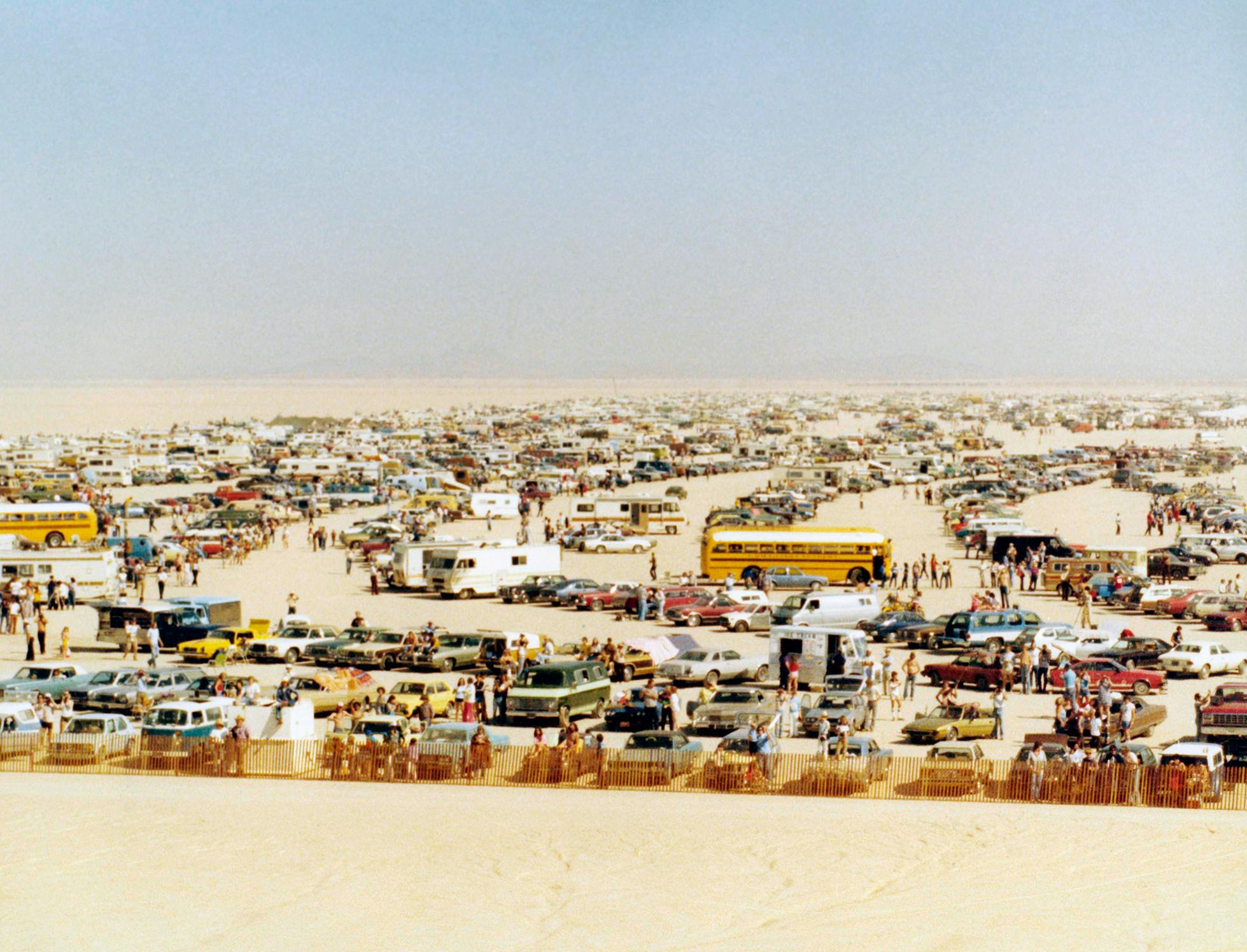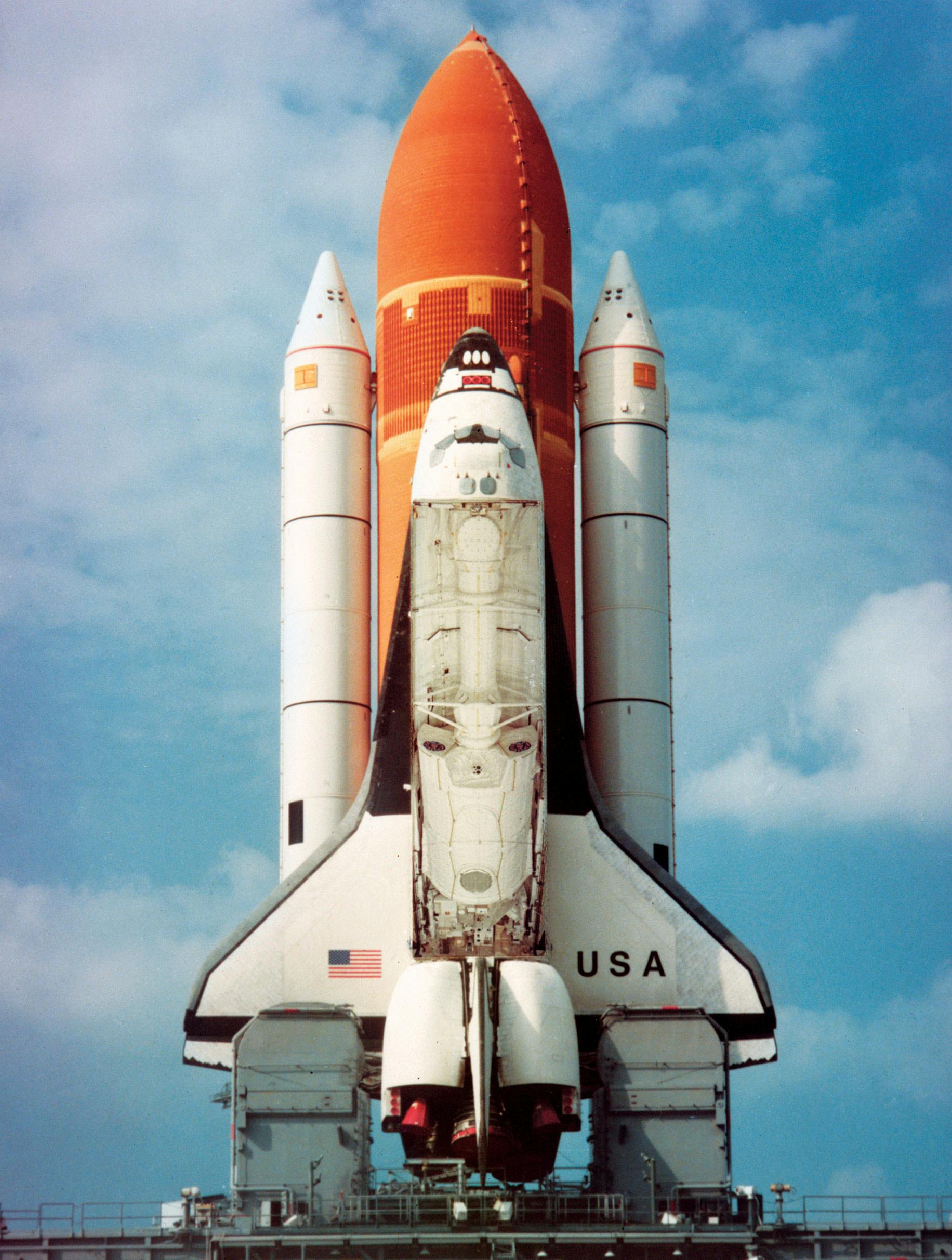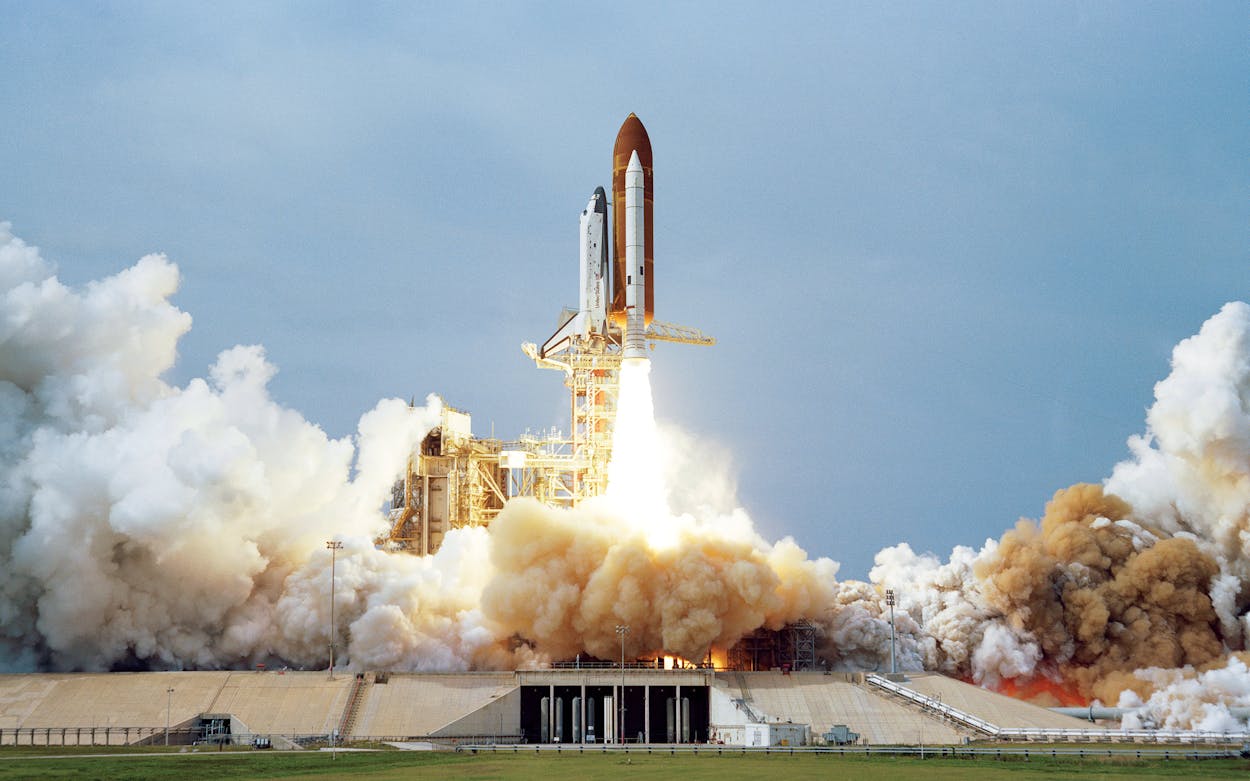In an ugly box of a building near the center of NASA in Houston, a phalanx of technocrats with photo ID cards pinned to their limp shirts sat at an array of radio and computer consoles imposing enough to make George Orwell, were he alive here at the dawn of 1984, shrink in recognition. These technocrats, like Orwell’s, held certain lives in their grasp, for they were working at Mission Control, where they were dictating the activities of the six men aboard the space shuttle and its orbiting scientific laboratory. Also like Orwell’s, these technocrats insisted upon routines prescribed in government manuals. Whatever variations were permitted were often determined by the readouts from computers and were expressed in acronyms and jargon, incomprehensible to the uninitiated. It was all strikingly like the vision of the future that Orwell expressed in 1984, but instead of bringing me to the brink of despair, watching those technocrats had exalted and excited my emotions. Here amid the grim, featureless buildings of NASA, every one of them unadorned and rectangular like some spiritless university campus, with dismal names like Building 1, Building 2, Building 3, surrounded by rows of apartments and low-slung tract houses and thick power lines leading north toward downtown Houston, I felt I was witnessing a regeneration of the human spirit by the very technocrats Orwell feared.
My enthusiasm had first arisen a week earlier, when in one day I witnessed two visions of the future. I watched the space shuttle take off from Cape Canaveral and visited Walt Disney’s Epcot Center, only an hour’s drive inland. Cape Canaveral, which is now part of the John F. Kennedy Space Center, is not in the most beautiful part of Florida, but it maintains an easy, mid-American, cutoffs-and-flip-flops congeniality. NASA snuggles here quite serenely. Its launching pads and fuel tanks stand solemnly among motionless brown rivulets, tough scrub, and slack, woeful trees. We were warned during a press tour to stay away from the brush, lest we step on a snake. The public information officer assigned to guide us seemed as eager to point out families of raccoons and other fauna as he was to show off the rockets, perhaps the greatest technological wonder in history, which he referred to in military slang as “birds.”
It was not very long ago that “firecrackers” would have been a more appropriate word for them. Even into the thirties the fuses of American experimental rockets often had to be lit with matches. In May 1961 a Redstone rocket carried Alan Shepard, the first American in space, 116 miles into the heavens. Redstones stand today at the entrances to NASA in Florida and in Houston. Held up by guy wires, no taller than the flagpole in front of a post office, their ugly black-and- white-checkered paint jobs peeling in the salty coastal air, they look awkward and puny, hardly the focus of American dreams, not even a vehicle to which a man with any sense would trust his life. Yet that spring more than twenty years ago the Redstone was both. Even the astronauts regarded it as diminutive. “Light this candle,” Shepard insisted as he waited impatiently on the launching pad.
The control room for that mission still stands at Cape Canaveral. Forlorn, now a museum, its huge old hulking computers and rows of round dials behind thick glass, its stolid IBM electric typewriters and oversized log books and glass windows built into concrete blocks, its spidery old government office chairs mounted on little hard rubber wheels no bigger around than a penny, it looks like some dismal encampment headquarters left over from Korea rather than like the nerve center that sent our first spasmodic but successful twitch toward the stars.

The day before the shuttle launch, people had already begun parking their campers and pickups along the causeways and roadsides that offered a view of the launching pad. The press gallery within NASA was somewhat closer than those outside vantage points, but it was still more than three miles away across a lake and a wide stand of brush. Even through binoculars the shuttle looked like a hazy gray blip on the horizon, a mutant branch thrusting slightly above the otherwise even row of distant trees. People milled around all day, wondering about the weather, which threatened to delay the launch.
But the desultory pace of the day before was no preparation for the intensity of seeing the launch. The weather did not prove to be a problem, and in the press compound we watched on television monitors as the six astronauts entered the shuttle. They seemed eager and somewhat self-conscious for being on display, as they put on their helmets and zipped up their suits with the help of the ground crew. The exception was John Young, already a veteran of five flights and 587 hours in space. He acted nonchalant, bored with the routine, ready to get on with it and light the candle.
With 65 minutes left in the countdown, the cabin hatch was closed behind them. With 7 minutes to go, the steel crosswalk by which they had entered the shuttle from the gantry was retracted. With 25 seconds remaining, the computer on board the shuttle took over the management of the countdown. Outside, water started pouring from six nozzles, each one twelve feet tall, covering the launch pad. The flood would dissipate the sound waves from the engines and prevent them from bouncing back up and cracking the rocket. With 3.46 seconds to go, the engines started, and it was immediately clear why three miles away was as close as you would want to get. What had been the hazy blip on the horizon suddenly began spewing flames so intense that even at such a distance, you wondered if watching them would damage your eyes. Huge, roiling clouds of water vapor, pure white, billowed up from the base of the rocket, and then the sound arrived. It came as a heated, hollow roar, like a vengeful wind in summer, and you could feel it rushing past your face. Even at that distance the ground trembled and the press gallery, apparently solidly built, shook and clattered. The rocket by now had lifted off the pad. With a white stiletto of flame shooting from its engines, it began its long, arching climb toward the heavens. It seemed to catch you in its wake, to pull your breath along with it, and when it finally disappeared into the clouds, you continued to watch, with all your nerves revving.

Immediately after the launch all the control shifted to Houston, and people started to leave the cape. The nearest airport is Orlando, which in turn is only a few miles from Walt Disney World and Disney’s vision of the technological future, Epcot Center. The name, like NASA’s, is an acronym, standing for “Experimental Prototype Community of Tomorrow.” The center is divided into two parts, the World Showcase and Future World, both of which have on first impression their own kooky grandeur. The World Showcase rings the shores of a placid lake with nine groups of buildings that represent nine different countries. At Future World, in a group of steel-and-glass buildings in exotic shapes, some of our largest corporations present their world visions: Exxon on energy, General Motors on transportation, Kodak on imagination, and AT&T on Spaceship Earth. You enter the pavilions, step onto a tram, and ride into the dark bowels of the building, where you are assaulted with dioramas, films, and sound effects, all purporting to show the accomplishments of the past and the wonders man has yet to achieve.
These displays have their moments. In General Electric’s Horizons, whose main theme is life in the next century, there are a few seconds —too few for me—when you experience the illusion of floating among the skyscrapers of New York. These effects are accompanied by a sound track that compliments you for the great reservoirs of genius and creativity that lie within us all. “If we can dream it, we can do it,” General Electric says.
At the same time, the opportunities to make your own choices during these rides are nil, and you are assumed to be capable of absorbing so little real information that the effect, contrary to the exaltation of the spirit from seeing the rocket, is deadening to the mind and oppressive toward exactly the creative sparks the exhibits pretend to admire. In the Bell System’s presentation of the history of mankind, religion (certainly an important influence on creativity) is never mentioned. I’m sure this is to avoid offending anyone, but the result of such fastidiousness is that the model of Michelangelo is described as painting the “Sistine ceiling.” Did AT&T think non-Catholics would rise in collective fury upon hearing the word “chapel”?


The glory of the space program is that in fifty years we have gone from setting off rockets with matches to sending up laboratories where six men can live for ten days and return to Earth as gently as a jetliner pulls into DFW. This accomplishment came not by dreaming, at least not in any ordinary sense of the word, but by solving problems. It is easy to imagine flying to the stars, but it is far different to work out the mechanics of loading volatile propellants into a rocket engine and getting them to ignite at the proper moment. The shuttle’s takeoff is an exhilarating spectacle because it is incontrovertible proof that all the problems that stood in its way were solved by human energy and intelligence. Nowhere in Epcot Center is there any recognition of the puzzlement and frustration, the short tempers and jealousies, the obduracy of natural laws and the whims of chance, that stand in the way of anything worth doing. The center’s message is “Imagine”; the shuttle’s is “Think.” You leave Epcot starved for something real, out of sorts at being kept on such a short tether and talked down to, anxious to get on with your own life. It is Disney’s vision of the future, not NASA’s, that Orwell would find abhorrent.
In Houston, poking around NASA, you come to understand a future that seems exotic and daring, but livable after all. It’s human. I was relieved to learn that astronauts get dirty hair, for which they carry Prell into outer space. They get chapped hands and need Keri lotion, and they smell at close quarters after a day’s work and thus stick Old Spice into their hygiene kits. Their food looks pretty vile by Earth’s standards, and sometimes hydrogen leaks into their water supply and they have to swing the water around in bags designed to collect urine in order to force the gas out. They get testy with Mission Control and sometimes prefer to go jogging on their treadmill rather than submit to another tedious—to them—in-orbit press conference. Also at NASA, in a bunker of a structure named Building 31 A, through an industrial steel door and up a flight of concrete stairs with cold steel handrails, you can see into a working laboratory where there are rocks from the moon. Elsewhere, in Building 2 and Building 5 and Building 9A, you see, beneath the fluorescent lights, amid the gray desks and the banks of blue computers, on the sterile linoleum floors, and next to the plain white walls, the work of the anonymous thousands who spend each working day reaching into the skies and carrying us along.
- More About:
- Space







